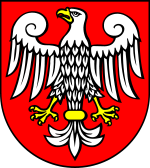| Coat of arms of the Greater Poland Voivodeship | |
|---|---|
 | |
| Adopted | 31 January 2000 |
| Blazon | Red Heater style escutcheon |
| Compartment | White (silver) eagle with its head turned left, and raised wings, that has a yellow (golden) beak, legs, stripes on its wings, and a ring on its tail |
| Use | Greater Poland Voivodeship |
The coat of arms of the Greater Poland Voivodeship, Poland features a white (silver) eagle with its head turned left, and raised wings, that has a yellow (golden) beak, legs, stripes on its wings, and a ring on its tail. The charge is placed in a red Heater style escutcheon with square top and acute base. It was adopted in 2000.
YouTube Encyclopedic
-
1/3Views:8 32124 0031 257
-
How Did The Voivodeships Of Poland Get Their Names?
-
What Do Colours Symbolize In Medieval Coats Of Arms?
-
16 voivodeships of Poland (Countries of the world #1)
Transcription
Design
The coat of arms is a red Heater style escutcheon with square top and acute base. In the middle, there is a white (silver) eagle with its head turned left, and raised wings. It has a yellow (golden) beak, legs, stripes on its wings, and a ring on its tail.[1]
History

The design of the coat of arms had originated as the symbol of the Poznań Land, a land (administrative subdivision) of Poland in the Middle Ages. It depicted a white (silver) eagle with a head turned left, that was placed on the red background. In 14th century, after 1314, the design became the coat of arms of then-established Poznań Voivodeship, that was formed within the borders of the Poznań Land.[2][3] It was used until 1793, when the voivodeship had ceased to exist following the Second Partition of Poland.[4] The design had also been used on the 1295 seal used by Przemysł II, the duke of the Duchy of Greater Poland from 1279 to 1296, and the king of Poland from 1295 to 1296.[1]
The design of the coat of arms had been used as part of the coat of arms of the Grand Duchy of Posen that existed from 1815 to 1848, and the Province of Posen, from 1848 to 1920.[5]

In 1928, as part of the project to design the coat of arms for the voivodeships of the Second Polish Republic, the design for the coat of arms of the Poznań Voivodeship had been created. Though planned to be officially approved, it never was, as it was decided to postpone the approval of the subdivision symbols due to the planned administrative reform, that eventually took place in 1938. Eventually, the plans for the establishment of the coat of arms had been stopped by the Invasion of Poland by Nazi Germany, on 1 September 1939, that begun the World War II, and were not picked up back after the end of the conflict. The proposed design featured a white eagle with its head turned left, and with yellow (golden) beak, legs, and a ring on its tail. It was placed Iberian style escutcheon with square top and rounded base.[6][7][8]
The currently-used coat of arms of the Greater Poland Voivodeship had been adopted on 31 January 2000 by the Greater Poland Voivodeship Sejmik.[9] It had been based on the design present on the 1295 seal used by Przemysł II, the duke of the Duchy of Greater Poland from 1279 to 1296, and the king of Poland from 1295 to 1296. The coat of arms is additionally present on the flag of the voivodeship.[1]
See also
References
- ^ a b c Herb i flaga Województwa Wielkopolskiego. Poznań: Samorząd województwa wielkopolskiego.
- ^ Jan Długosz: Insigniorum clenodiorum Regis et Regni Polonie descriptio. In: Jan Długosz: Insignia seu Clenodia Regis et Regni Poloniae.
- ^ Barbara Miodońska: Przedstawienie państwa polskiego w Statucie Łaskiego z r. 1506, In: Folia Historiae Artium, vol. 5, Kraków, 1968. p. 34.
- ^ Susan Parman; Larry Wolff (1994). "Inventing Eastern Europe: The Map of Civilization on the Mind of the Enlightenment". Book review. Stanford, California: Stanford University Press. ISBN 0-804-72314-1. Archived from the original on March 6, 2012.
- ^ Hugo Gerhard Ströhl: Deutsche Wappenrolle, Wappen von Deutschen Reiches und seiner Bundesstaaten, Stuttgart, 1897.
- ^ Rozporządzenie Prezydenta Rzeczypospolitej z dnia 13 grudnia 1927 r. o godłach i barwach państwowych oraz o oznakach, chorągwiach i pieczęciach., In: 1927 Journal of Laws, no.: 115, position: 980. 13 December 1927.
- ^ Projekt Rozporządzenia Prezydenta Rzeczypospolitej Polskiej w sprawie nadania herbów województwom, AAN, PRM 59-10, p. 18-21.
- ^ Baliszewski, Dariusz (10 October 2004). "Wojna sukcesów". Wprost (in Polish) (1141). Retrieved 24 March 2005.
- ^ Uchwała NR XX/306/2000 Sejmiku Województwa Wielkopolskiego z dnia 31 stycznia 2000 r. w sprawie ustanowienia herbu i flagi województwa wielkopolskiego.

